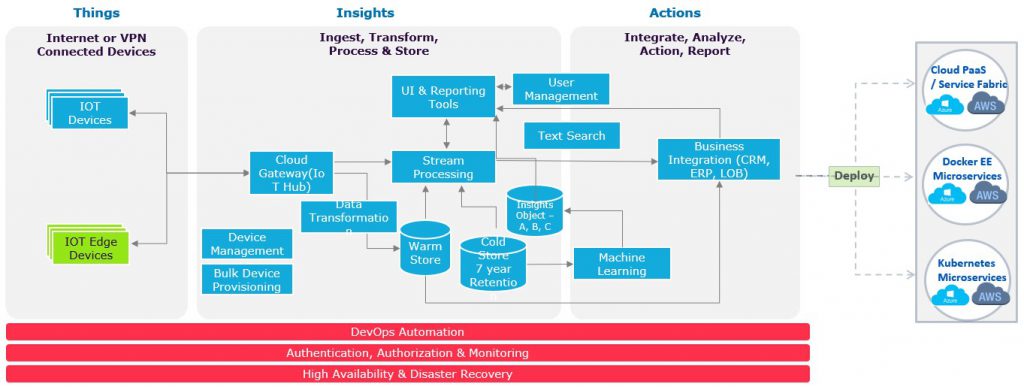In the changed lifestyle of today, we have lots of electronic devices around us which are generating lots of data. The data generated by these devices may not look useful in its raw form but if we analyze and process it in the context of business, there is a huge value which comes out of it. If we have to process and analyze this data, then we need a robust platform like the cloud which is scalable and reliable to process and store this data.
The concept of collecting this data from these devices and ingesting and processing it in cloud platform is known as IoT i.e. Internet of Things. Cloud platform provides shared services around IoT space which helps to expedite the IoT implementation use cases. Once IoT use cases are implemented, it helps businesses capture real-time events and avoid business losses by taking timely decisions. An ideal way to implement the IoT platform could be with the use of IoT Lambda Architecture and blueprint of it will look as below:
 There are no doubts that IoT brings benefits to the business but over a period due to the huge amount of data ingestion and processing businesses comes across to below challenges:
There are no doubts that IoT brings benefits to the business but over a period due to the huge amount of data ingestion and processing businesses comes across to below challenges:
- Increased cost of running these systems on the cloud
- Data congestion on network due increase in data ingestion units
- Poor connectivity due to physical distance which results in latency
- Latency of response back results in missing on critical business event
 As shown in the above diagram Edge Devices are processing units with increased compute power which has the capability of processing and storing real-time data near to the sensor devices and brings the below benefits to the business:
As shown in the above diagram Edge Devices are processing units with increased compute power which has the capability of processing and storing real-time data near to the sensor devices and brings the below benefits to the business:
- Eliminates the single point of failure
- Reduce latency and improve response time
- Data is stored and processed on edge instead of transmitting to cloud platform
- Reduce the cost of transmitting and processing huge data on cloud
 Security is one of the main concerns with IoT devices running on the edge of the network because of their limited compute power and constraints of implementing security algorithms in it. Edge Connect block form the IoT architecture expanded below allows to implement different communication protocols and security algorithms as shown below:
Security is one of the main concerns with IoT devices running on the edge of the network because of their limited compute power and constraints of implementing security algorithms in it. Edge Connect block form the IoT architecture expanded below allows to implement different communication protocols and security algorithms as shown below:
 Internet of Things communication protocols shown in the diagram are listed below:
Internet of Things communication protocols shown in the diagram are listed below:
- Hypertext Transfer Protocol (HTTPS)
- Advanced Message Queueing Protocol (AMQP)
- WebSocket protocol
- MQ Telemetry Transport (MQTT)
- Constrained Application Protocol (CoAP)
- OPC Unified Architecture (OPC UA) – Custom

 English | EN
English | EN 

Hi,
What i feel in terms of reducing the cost as explained above, it is the shifting of cost from the cloud based companies to the customers who will avail these service. The edge computing which will be processing data near to devices is not clear will it be enhanced by the infrastructure given by cloud based companies or will it be the devices owned by the customer needs to be upgraded with enhance computing capabilities, if latter is the case then certainly it is shifting of cost. Can you please elaborate more on this aspect.
Hey Khalid,
Hope you are doing fine!!! I would not say it passing the cost to customer side because the IoT device or field gateway is already exists here and only additional thing being done here is to add compute capacity to device or field gateway. The additional compute power added to devices will help us identify the data with actions and alarm and send it to cloud and ignore the rest. This way it helps in saving the cost for network bandwidth and cloud storage. Hope it would clarify the doubts.